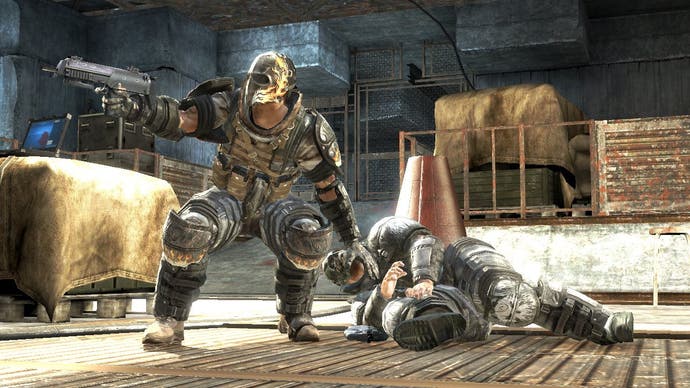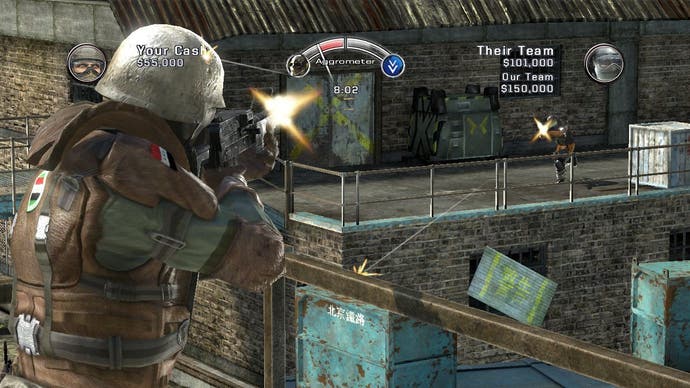Army of Two
I'm with stupid.
But with two evenly matched players, Army of Two immediately falls into a see-saw rhythm of cover and flank that's so natural, so instinctive and balanced, you barely need to communicate verbally with your team-mate until one of the slightly more involved boss battles comes around. It's made more flexible and powerful still by touches like the permanent, inset partner cam, or the aggro-dropping "feign death" move (which World of Warcraft players might recognise from the game's hunter class, and which recently saved some Norwegian children from a moose).
Aggro doesn't bring any revolutionary new tactics or dynamics to co-op play, but it promotes the core of it better than any shooter we can think of. "It works accidentally in a lot of other shooters, it's not really a feature," says Turner. "We really wanted to emphasise it, make it a major mechanic of the game, so you can choose the way you manipulate the AI and move through the maps."
Army of Two's other co-op systems seem more perfunctory: co-op sniping, weapon-switching (handy for trying out a friend's customised piece for a spell), step-jumps for reaching high areas, and the theatrical, back-to-back, slow-mo shoot-outs dispense one-shot buddy-movie moments without having any lasting impact. Parachuting into levels, with one player controlling the 'chute while the other snipes, is a typical example.

Healing is more significant of course, and this is the one area in which the game has changed radically since Tom saw it. The headline-grabbing tampon-insertion mini-game has been dropped completely, for breaking the game's flow and becoming repetitive. Or perhaps because the developers were getting sick of the jokes?
"We really liked the original idea, it was different and it was fun for the first few times," protests Turner. "But it got stale quickly. Within one session of play it would get kind of frustrating - you'd get sucked out of the fire fight and put in this little world where you're doing the same thing over and over again... So we made a system where you're always involved in the fight, no matter where you are or how hurt you are. It was tough, we really liked the mini-game and were sad to see it go, but it's a better game without it."
In its place is a system very similar to Valve's Left 4 Dead: the prone, dying player can keep shooting while his friend drags him to cover, where he can spend a few seconds dispensing a one-button infinite heal without getting shot at. Simple, intuitive, effective, and it doesn't stop the action for a second. Game developers don't often get credit for sacrificing original ideas in favour of straightforward ones, but EA Montreal was absolutely right to do so in this case.

We played Army of Two with a human partner only, and weren't given a chance to use the buddy AI that takes your friend's place. We'd be concerned about that if we ever had any intention of playing the game alone, but we don't. We'd worry that it's not deep enough, and that its characters and storyline are ridiculous and clichéd and wafer-thin, if we intended to engage our brains for more than a second during its thick-headed, shouty nonsense, but guess what? No chance. Army of Two is a pure co-op shooter, no less and definitely no more. As such, it's got a good shot at a brief reign as the best of its breed - brief, because the brilliant Left 4 Dead is snapping at its heels, and is even more exquisitely balanced for four players than EA's game is for two.
Maybe it's because so few games of its kind have been designed from the ground up for co-op play that Army of Two achieves so much with so little. It's great in a bluntly obvious, barefaced kind of way; to play it is to repeatedly slap your own forehead and make "duh" noises. Appropriate, perhaps, for a game in which you play a retarded hunk of muscle in a gimp suit, with a foul mouth and a gold-plated gun.


